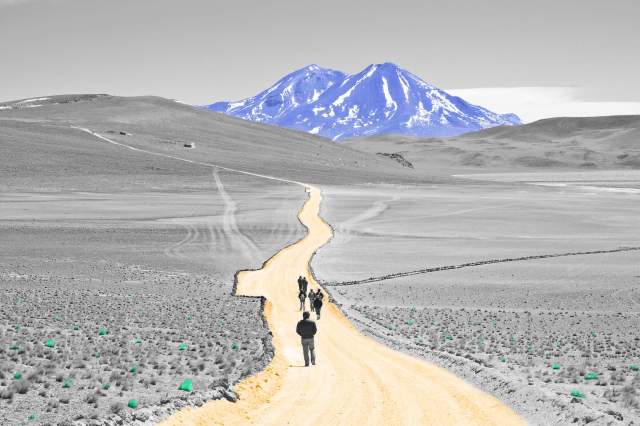
NASA Uses the Desert to Mimic Mars
When NASA decided to look for life on Mars, it started right here on Earth. In fact, one of the Atacama’s most famous valleys – Valle de Marte – translates to Mars Valley due to its resemblance to the red planet. The rough rocky surface, characterized by bumpy nodules of rock salt or halite, is as close as you’ll get without setting off for space. The Atacama Rover Astrobiology Drilling Studies project, or ARADS for short, has conducted a series of experiments in the region, from growing trees to testing vehicles.
Unsurprisingly, the Atacama Desert’s otherworldly landscape has made it the choice of several filmmakers, too, including in the British series Space Odyssey: Voyage to the Planets and the 2008 James Bond film Quantum of Solace (though not as Mars).

It’s One of the Best Places in the World for Stargazing
This remote, high-altitude locale — reaching elevations of 13,000 feet — also happens to be one of the best on the planet to observe the night sky. On average, the Atacama Desert experiences 330 cloud-free nights every year, a fact not overlooked by the world’s top astronomers. If you’re used to stargazing from a town or city, the sight of so many stars glittering against a pitch-black sky is sure to be jaw-dropping. Stargazing tours depart from the main tourist town of San Pedro de Atacama to an array of nearby telescopes, where an astronomer guide will help you spot constellations, nebulae and even the rings around Saturn.
Scientists flock here too. On the Chajnantor Plateau, the Atacama Large Millimeter Array, or ALMA for short, boasts a collection of 66 radio antennas — making it the largest radio telescope in the world. Collectively, those antennas are capable of identifying an object the size of a golf ball from a distance of 9 miles.
The European Southern Observatory operates another two sites in Chile’s Atacama Desert, at La Silla and Paranal. They’re also building what’s known as the Extremely Large Telescope (ELT), which should be able to collect 100 million times more light than the human eye, enabling it to search for planets circling stars and help boost understanding of black holes and galaxies.

Though It’s One of the Driest Places on Earth, the Fauna Is Surprisingly Diverse
Visitors to the Atacama Desert are often taken aback at just how much wildlife can exist in what appears to be such an inhospitable place. But there are places where rainfall is sufficient to support vegetation and animals, including wild Andean foxes, which live off lizards and small rodents. The viscacha, a type of chinchilla, can also be seen. Herders tend flocks of llamas, bringing them down to mountain lakes to graze. Their wild cousins, vicuñas and guanacos, are harder to locate, but migrate towards water sources.
Birdlife is also abundant. Some of those dazzling high altitude lakes and salt flats boast colorful flocks of flamingos. Where the desert meets the coast, Humboldt penguins nest in cliffs overlooking the ocean. Hummingbirds visit seasonally, drawn by nectar, seeds and insects. When there’s sufficient water to bring out the blooms on the region’s flowers, you might even spot birds of prey, such as burrowing owls.
More Interesting Reads

Water Is Harvested From Fog to Grow Crops — And Even Brew Beer
Around a million people live in the Atacama Desert, many of them making a living from copper or lithium mining or from tourism. But while the annual rainfall is less than 1 millimeter per year, some residents manage to grow crops via an ingenious method of fog harvesting called “camanchaca.” Near the coast, parts of the Atacama Desert are susceptible to thick fog, which rolls in off the Pacific Ocean. In the 1950s, a scientist called Carlos Espinosa Arancibia came up with the idea of a fog catcher — basically, a net with holes to capture the water vapor, which would collect and drip down the netting into a channel underneath. From there, the moisture could be piped to where it was needed and used to irrigate crops. Since then, research has continued and at the Atrapaniebla (Fog Catcher) Brewery in Peña Blanca, this precious water has even been used to make beer. The owners claim it is the only beer in the world to be produced in this way.

It’s Home to Mummies That Are Older Than Egypt’s
If you thought the mummies in Egypt’s ancient pyramids were the oldest on the planet, think again. The oldest Chinchorro mummy, the Acha man, dates back to approximately 7020 BCE, several thousand years before the first of the Egyptian mummies.
Around a third of these mummies, like Acha man, were mummified naturally, with the dry desert climate helping to preserve the bodies. Later, embalmers replaced internal organs with animal hair and created a clay mask in place of what would have been skin and flesh. Unusually, the Chinchorro people didn’t reserve mummification for royalty, nor did they favor one sex over the other. Archaeologists have recovered 282 Chinchorro mummies from the Atacama since the first discovery just over a century ago.











